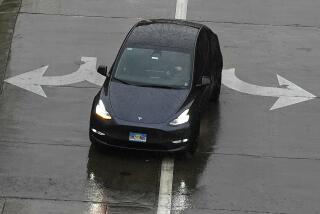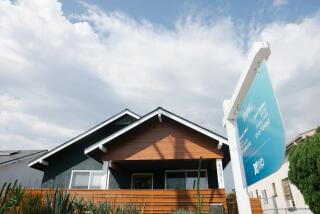Full Speed Ahead : After Slow Years, Local Car Dealerships’ Sales Are Zooming
After years of recession-induced doldrums, many local car dealers are now enjoying brisk sales, mirroring the trend nationwide and throughout California.
“We’re killing them,” said Rick Hanchett, general sales manager at Canoga Jeep Eagle in Canoga Park. “We’ve had record months ever since January. We can’t keep the cars on the ground.”
Canoga Jeep Eagle is cashing in on the explosive growth in demand for sport utility vehicles such as Chrysler Corp.’s Jeep Cherokee and the Ford Explorer. Hanchett said sales of the luxury Grand Cherokee models have been particularly strong. At one point, he had just one remaining Grand Cherokee on the lot, compared to the 40 to 60 he usually has in stock.
From the first of the year through mid-September, Canoga Jeep Eagle’s unit sales jumped 21% over the year earlier, to 783 from 649. And gross sales zoomed 36%, to $1.2 million from $880,000 in the 1993 period. Profit per car has also risen, Hanchett said, largely because of customers’ preference for luxury models and added features.
Across the San Fernando Valley and surrounding areas, many other car dealers are reporting that sales are finally picking up after remaining stagnant or declining since the beginning of the decade. The growth can’t come too soon for the local auto industry, which continued to suffer through 1993 as California’s economy lagged behind the rest of the country.
Nationwide, sales of domestic and Japanese vehicles were robust in the first half of the year, and the trend is expected to continue into 1995. Auto analysts say that sales in the United States are on a pace to hit a booming 15.5 million units this year, up from 14 million in 1993.
The analysts say that Southern California car sales still aren’t increasing as fast as those elsewhere in the country. But sales are gaining speed here, said Christopher Cedergren, senior vice president of the Santa Ana-based auto research firm AutoPacific Group Inc.
“There’s a lot of pent-up demand for cars,” Cedergren said. “The age of the fleet in California and the country is at a record high. There’s a lot of old cars on the road that need to be replaced.”
The good news for California dealers, he added, is that their car sales will probably continue to grow through 1997, when the rest of the country is expected to head into another cyclical economic downturn.
Granted, some of the local dealers seeing big increases have benefited from the closure of other dealerships throughout the area during the past several years. Many are also getting a boost from the upsurge in auto leasing, which is being fostered by heavy incentives offered by the manufacturers.
Both factors have helped sales balloon at Galpin Ford in North Hills, one of the two largest Ford dealers in the nation, said owner H. F. (Bert) Boeckmann II. In the first eight months of this year, Galpin Ford sold 7,354 new cars and trucks, up 35% from 5,440 vehicles sold in the comparable 1993 period. That helped fuel an overall sales gain of 35% for all new and used cars, to $192.5 million from January through August versus $142.7 million a year before.
Boeckmann said that his Galpin Lincoln-Mercury and Saturn dealerships have had similar increases. And while profits per car are down because of price cutting, total profits are rising because the volume of sales is so great. “When you get your volume up, that’s where you really make your money,” he said.
*
During the recession, when other dealerships were cutting back, Galpin kept expanding, a factor Boeckmann now cites as a key reason for his strong sales growth. And when other dealers closed--such as Mission Hills Ford, which went out of business in 1991--Galpin pulled in new customers.
Boeckmann also said that sales really took off this year after the earthquake, when the pent-up demand for new cars was unleashed. July and August were record sales months at Galpin Ford, he said, and September “could be our biggest month ever.”
That’s due in part to customers like Tom Ordorff of Tujunga, who has decided to buy one of the fast-selling Ford Escorts for his wife, their first new car in many years. “We put off buying for a long time,” Ordorff said, but his wife’s old car is now “trashed” and he wants her to have a new car for shuttling around their young daughter and 1-month-old son. Ordorff said he was also motivated by what he sees as good deals available on new cars recently.
With sales picking up, some local car dealers are finding themselves running short on inventory. That’s because manufacturers steered car allotments to the Midwest and East, where sales began rebounding sooner.
“My biggest problem is keeping cars in stock,” said Peter Tuohy, sales manager at Keyes European in Van Nuys, which sells Mercedes-Benzes and Volvos.
Nonetheless, Tuohy said sales are up 15% to 20% over last year. He attributed the increase, which started about three months ago, to a rush to buy cars at the end of the 1994 model year and lower prices for the top-of-the-line S-class Mercedes.
Many dealers say that manufacturers’ incentives have helped their sales, but other factors have had an impact as well. At Star Auto Group in Glendale--which includes Ford, Chrysler-Plymouth-Jeep, Lincoln-Mercury, Saab, Acura and Isuzu dealers--Vice President Steve Bussjaeger said car sales are up 16% over a year ago and truck sales have skyrocketed 44%.
Bussjaeger attributed the increases mostly to the auto group’s move more than a year ago to a facility three times the size of its former site, while at the same time adopting a lower-pricing strategy. As at Galpin, the profit margin on each car sold has been squeezed, but “we’re doing so much more volume that it makes it well worth it,” Bussjaeger said.
In addition to booming sales of sport utility vehicles made by Ford and Chrysler, he said, the van business is hot, including the Ford Aerostar and Windstar and Chrysler minivans. Some dealers also have high hopes for the newly redesigned Chevrolet Blazer.
There are exceptions to the local surge in sales. Some dealers of Japanese-made vehicles are having a harder time lately because the strong yen has forced up the prices of their cars, although some Japanese cars sold here aren’t affected because they are made here. What’s more, although Japanese car manufacturers have been seeing overall sales increases in the United States, they are up against the toughest price and quality competition in years from resurgent Detroit automakers.
Through much of the 1980s, Hondas were among the best-selling cars, but Rick Gart, sales manager at Honda of Valencia, said his sales are stagnant now, as they have been for the past few years. “Right now it’s a rough situation, because you’re in between the old models and the new models,” Gart said. Ideally, he’d like to have all the 1994 model cars sold by the end of the year, but he is worried that rising interest rates could hurt that effort.
Jay Gorman, executive vice president of the California Motor Car Dealers Assn., a Playa del Rey-based industry group, cautioned that, although the picture has improved for many area dealers, auto sales here will probably still lag the rest of the country for some time.
“I think you’re going to see relatively stable sales” through next year, he said. But in Southern California “we’ve had a devastated aerospace and defense industry. I think that’s going to continue to have an impact. The people we’ve talked to don’t see a real red-hot market.”







